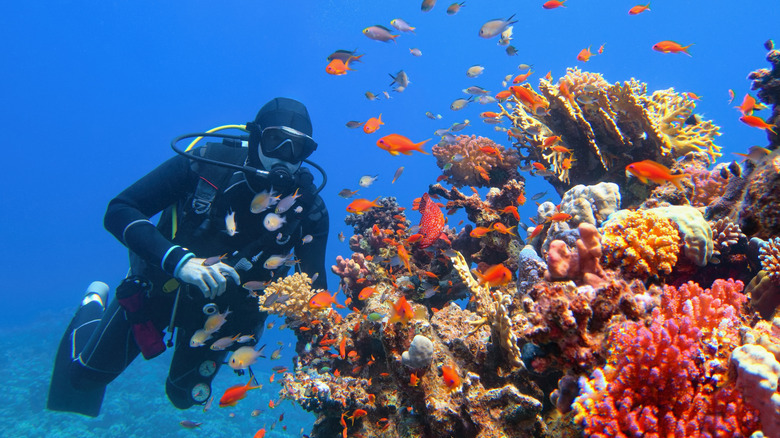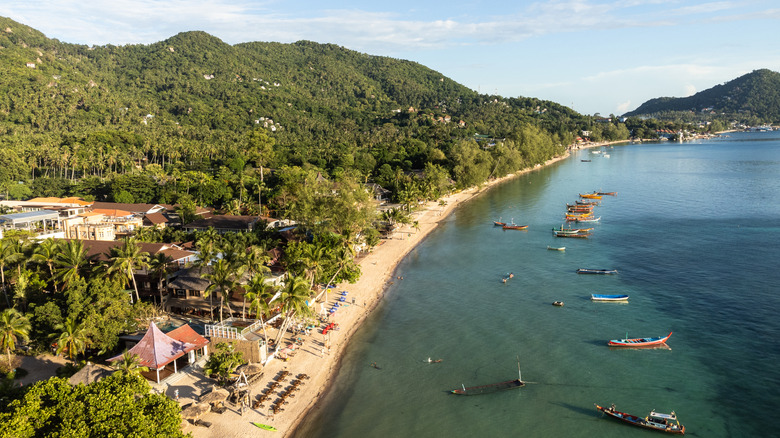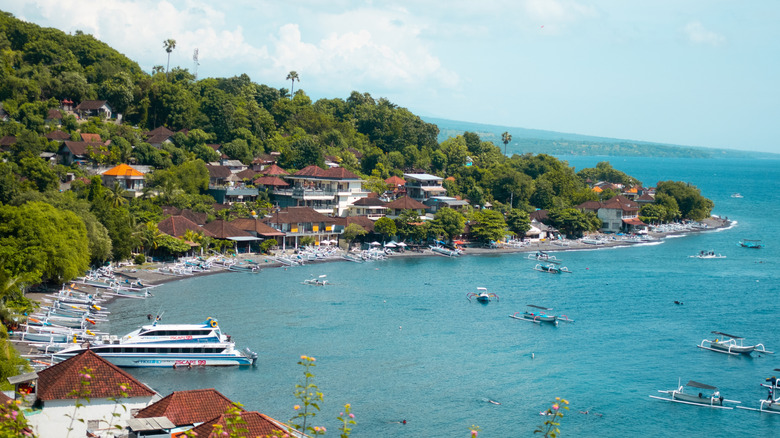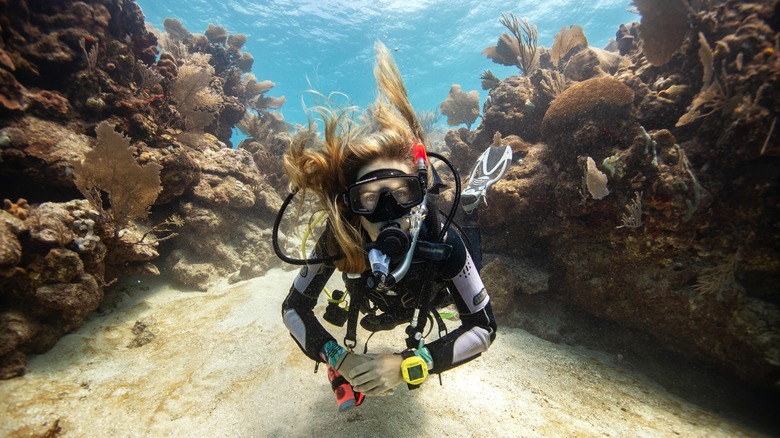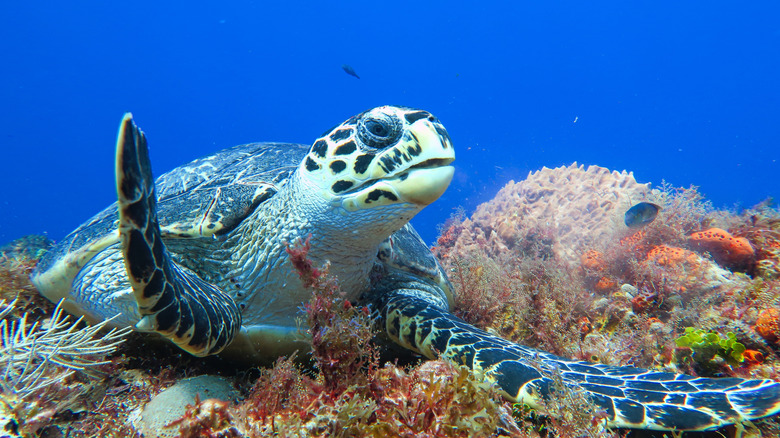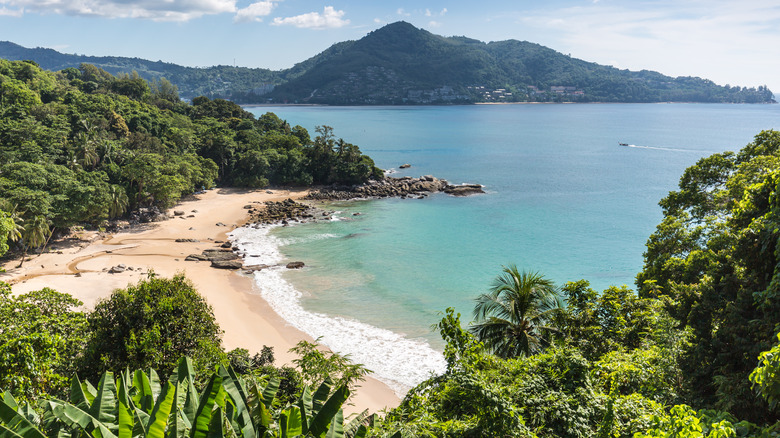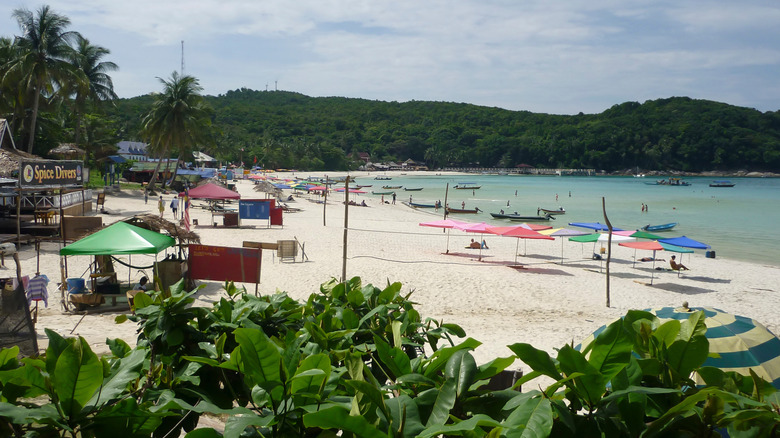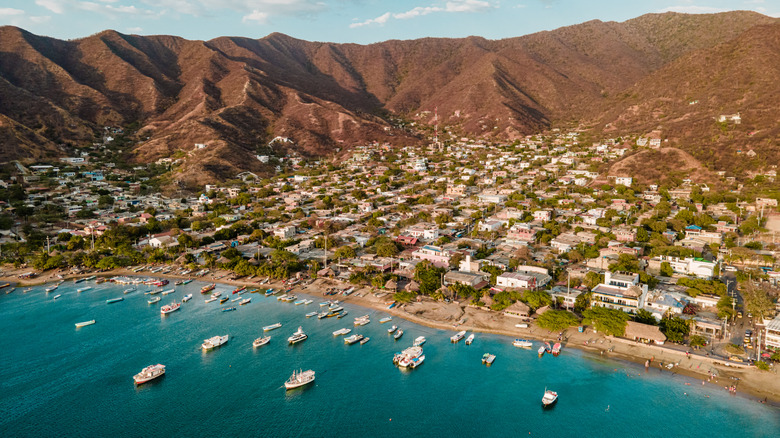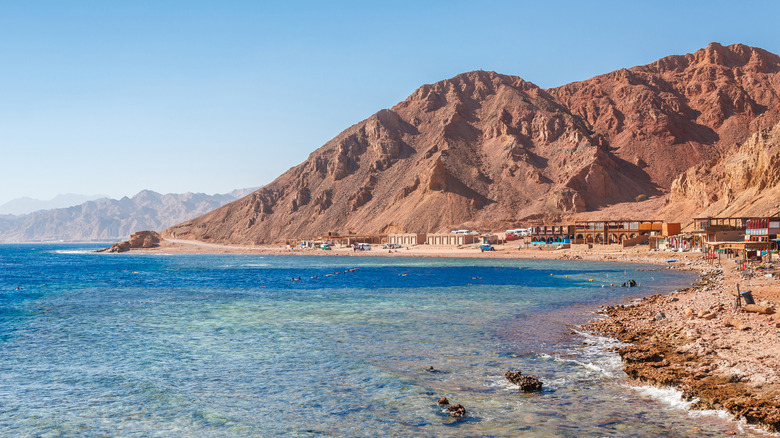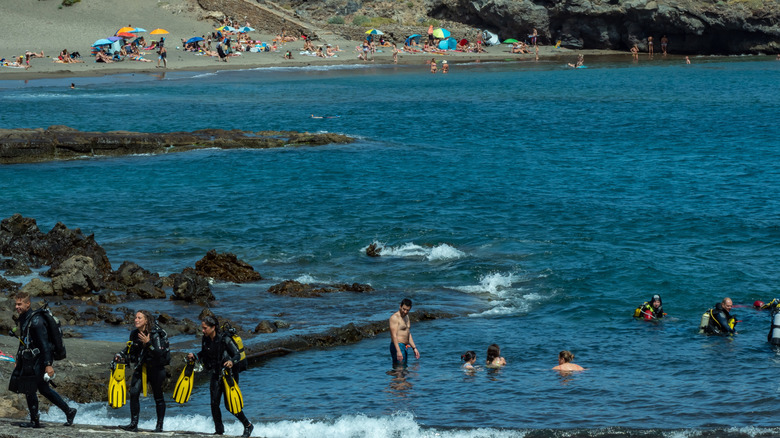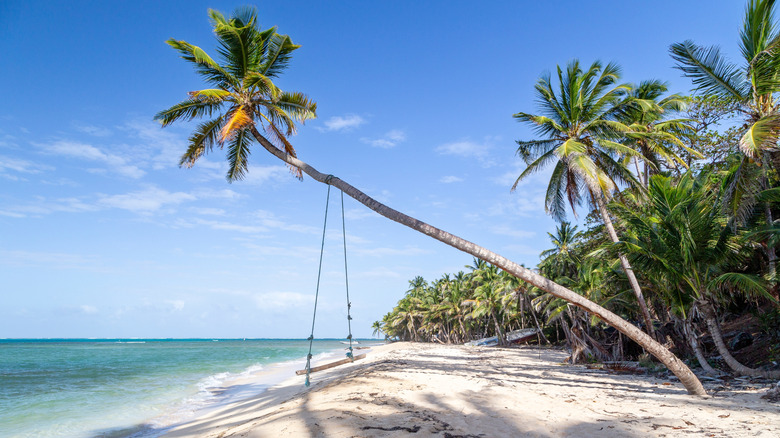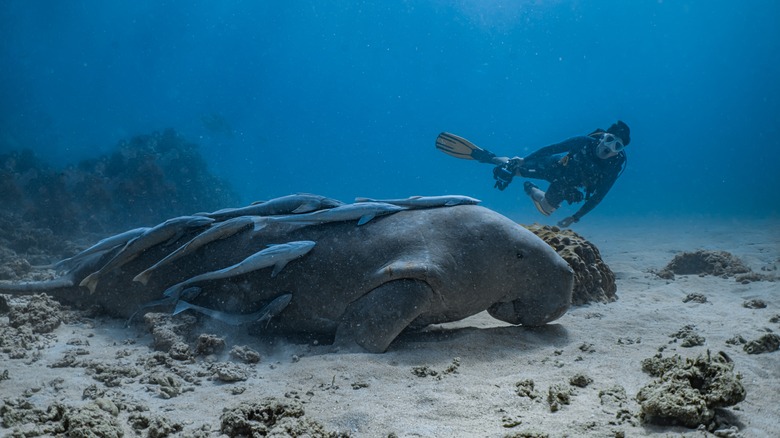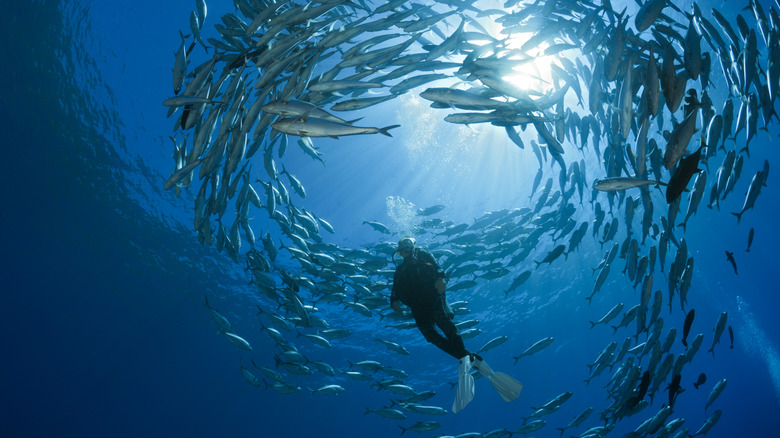The Cheapest Destination-Worthy Places In The World To Get Scuba Certified
Getting certified in scuba diving is one of those things you can do that will literally open up a whole new world to explore: the underwater world, which is full of colorful coral reefs and marine life. Sure, you can get scuba-certified near your home, but it's also a good excuse to go somewhere destination-worthy. There are plenty of great destinations around the world that offer cheaper dive certification courses compared to the United States, and these destinations have a lot more to explore above the water as well.
It's important to properly learn how to keep yourself safe underwater, however, so you shouldn't only look for the cheapest certification course. Look for dive shops with experienced instructors and well-maintained gear. Also, check out the dive shop's reputation and reviews before you commit.
There are actually a number of different diving organizations that offer scuba diving certifications, but PADI (Professional Association of Diving Instructors) is the largest in the world for recreational divers. Regardless of the destination in the world you're diving at, you'll likely encounter a PADI-affiliated dive shop there. For the purposes of this list, we'll be comparing prices for PADI Open Water Certification, which is the beginner certification for recreational diving from PADI. We looked at scuba blogs and forums and even checked out the official PADI website for locations. Check out this beginner's guide to scuba diving to learn more about how to get started, then use the list below to get inspired and plan your trip to get certified.
Koh Tao, Thailand
Koh Tao is considered one of the best Thailand islands to visit that reputation is mainly due to its scuba diving scene. This island in the Gulf of Thailand has 21 kilometers of beautiful coastline and is considered one of the best places to dive in Thailand with more than 26 different dive sites. There is quite a bit to explore underwater in Koh Tao, from coral reefs to rock pinnacles to shipwrecks.
Of course, Thailand is known to be inexpensive to visit, and that also goes for Koh Tao. Not only are the accommodations and food costs budget-friendly, but the open water diving course here also costs less than it does in the United States. The full certification package goes for around $335 in Koh Tao, compared to the $495 it would cost to do it in Hawaii. There's a range of accommodations in Koh Tao, but you can still stay at a locally-owned guest house for under $50 a night.
Once certified, there are dive sites meant for more advanced divers worth returning for. Chumphon Pinnacle, for example, gives the chance to see large schools of barracudas. Whale shark sightings are also possible when diving at the deeper dive sites around Koh Tao.
Amed, Indonesia
The paradise island of Bali is certainly great for scuba diving, but the high tourism there means that Bali is no longer a cheap destination. Thankfully, though, there are still villages like Amed in the less-crowded northeastern part of the island that are affordable. Of course, Amed didn't become a diving hub just because it's affordable. Amed offers some great dive sites and many of them are accessible from the beach, meaning you don't need to go on a boat trip to go diving, which is also a plus if you tend to get seasick.
The Japanese Wreck dive site is shallow and accessible from the shore, making it one of the more beginner-friendly wreck dives. For those who like microscopic creatures, you can find plenty of nudibranchs around Amed. On the larger end of the size spectrum of marine life, you can spot sharks, pufferfish, and more. You can get scuba-certified in Amed for around $343 and stay at a lodge for $30 a night. Of course, once you're there, there's the whole island of Bali to explore. For a change of scenery, you can head to the artsy Ubud neighborhood in the jungles of Bali.
Utila, Honduras
Utila is a secret Central American island off the coast of Honduras with not only beautiful sandy beaches but also the world's second-largest barrier reef, the Mesoamerican Barrier Reef. There is an impressive number of different dive sites — around 60 of them — for such a small island (Utila is only around 16 square miles). While some say diving around the larger island of Roatan offers more marine life viewing than Utila, there's plenty to see at either location and in Utila, there is the chance to spot whale sharks year-round.
In addition, for beginners, Utila is the place to go as there are numerous dive shops and training centers offering certification courses. It doesn't hurt that Utila is known to be one of the cheapest places to dive in the world. Bay Islands College of Diving is a well-rated dive outfitter that offers open water courses for $350. On Utila, you can stay at a beach resort for $80 a night or opt for budget accommodations for around $23 a night. Utila's affordability attracts a lot of younger, backpacker crowds, so it has a lively nightlife scene.
Cozumel, Mexico
Cozumel is an island in Mexico located right off the coast of Playa Del Carmen. There are a lot of ferries that run between the two and the ride takes about 45 minutes each way. Cozumel attracts a lot of tourists thanks to its sandy beaches and crystal clear waters of the Caribbean Sea and it's also a popular cruise port.
In addition to all that, Cozumel is considered the diving capital of Latin America. There are numerous dive sites around Cozumel and even at beginner-friendly sites, you can spot turtles, snappers, angelfish, lobster, and more. More experienced divers come to Cozumel for the advanced dive sites where there are eagle rays, nurse sharks, and hammerheads.
You can book dive excursions to Cozumel from Playa del Carmen, but it's probably easiest to just stay on the island. There are a lot of expensive hotels and all-inclusive resorts in Cozumel, but a dive trip here can still be done on a budget. A package from Cozumel Dive School goes for $475 but it includes three nights of dorm-style lodging. If you don't want to stay in a dorm-style accommodation, you can find $50 hotel rooms and there are four-star bungalows available in Cozumel for under $90 a night.
Phuket, Thailand
Phuket may be mainly known for its beaches and these days for its nightlife scene, but there's also great diving to be found here as it's located on the Andaman Sea. There are beautiful reefs right near Phuket itself, and you can also easily do a day trip from here to two islands that are great for scuba: Koh Racha Yai and Koh Racha Noi. The Banana Bay dive site at Racha Noi has clear waters and the opportunity to encounter manta rays, leopard sharks, and giant guitarfish. At the dive sites around Phuket, you can spot leopard sharks, lionfish, moray eels, and more.
Because there are reefs right near the shore of Phuket, you can get open water certified in Phuket starting from 9900 Thai baht (around $292) by doing shore dives where you enter the water by walking from the beach. Shore dives are cheaper because you don't have to pay for the boat expenses such as fuel and boat crew. In addition, while Phuket is a popular tourist destination with some higher-end hotels, it's also still easy to find four-star hotel stays for under $50 a night.
Perhentian Islands, Malaysia
Perhentian Islands is a group of islands off the coast of Malaysia with two main isles: Perhentian Besar (Big Perhentian) and Perhentian Kecil (Small Perhentian). To get to Perhentian Islands, you'd need to get to Kuala Besut Jetty (most likely by flying to Kota Bharu or Kuala Terengganu and taking a car or bus to the jetty) then take a 30 to 45-minute boat ride to either Perhentian Besar or Perhentian Kecil. Both islands are located within the protected Terengganu Marine Park which makes either island a great base for some world-class scuba diving. Perhentian Kecil in particular is known to be more budget friendly while Perhentian Besar has nicer resorts. but either island gives you the same access to scuba diving.
Some of the marine life you can spot around the Perhentian Islands include barracuda, scorpionfish, rays, turtles, and more. There are also a few shipwrecks including Sugar Wreck, which is considered the best dive site in the area. In the Perhentian Islands, you can get open water certified for 1390 Malaysian ringgit, which is about $315 with the current conversion rate. You can stay at a dive resort for $30 a night and there are budget guesthouses on Perhentian Kecil for even less.
Taganga, Colombia
Taganga is a fishing village on the northern coast of Colombia about 15 minutes away from Santa Marta. Most travelers don't really come to Taganga for its beach as there are better beaches around, but it's a popular diving hub in the area. There are plenty of dive shops in Taganga because it's a jumping-off point to dive in nearby Tayrona National Park. The national park itself is also worth exploring above ground, with some stunning beaches and an indigenous village.
The underwater part of the national park has more than 30 dive sites that range in difficulty. There are shipwrecks and hidden caves, but there are also a number of beginner-friendly dive sites that are great for people working to get scuba-certified. Plus, diving in Taganga is quite affordable because there are a lot of dive shops competing with each other. For example, Ocean Lovers Taganga offers a package for $375 which includes a two-night stay at its dorm-style accommodations. Of course, you want to choose a legitimate dive shop instead of going for the cheapest option, so pay attention to reviews and the condition of the shop's equipment.
Dahab, Egypt
Egypt may not be the first destination to come to mind for scuba diving with its mostly desert landscape, but those who scuba dive know that the Red Sea offers some of the best diving in the world. The seaside town of Dahab started as a fishing village but is now a diving hub with easy access to the Red Sea. Dahab's most famous dive site is a dangerous spot called the Blue Hole but not to worry, there are plenty of easy dive sites for beginners who are still learning.
There's abundant marine life, colorful coral reefs, and shipwrecks to explore in the waters near Dahab. Plus, you may even encounter dugongs while under the water. The dive site called Lighthouse is a popular site for open water courses and you can spot moray eels and turtles here. You can find open water dive courses in Dahab for around $343. Accommodations are quite affordable in Dahab, as well. You can stay at a great beachfront lodging for $50 a night. Afterward, explore the desert and slot canyons around the area, or hike up to Mt. Sinai if you're looking for a challenge.
Tenerife, Spain
Tenerife is the largest island of Spain's Canary Islands and while Europe isn't typically considered a cheap destination compared to places like Southeast Asia, Tenerife still offers a good value. In addition, Tenerife's underwater terrain is a bit unique. The island's volcanic features extend to under the water. You can dive in caverns and lava tubes in Tenerife (though it's best to do those when you're more experienced), and there are lava rock reefs instead of coral reefs. As far as marine life goes, eagle rays and round stingrays are common around Tenerife. Lucky divers might also encounter a pod of dolphins.
Open water diver courses are available on Tenerife for €399 which is around $415 with the current conversion rate. While lodging in Spain isn't as cheap as in places like Thailand, you can still find hotels for $50 a night in Tenerife. Plus, there's plenty to see and do in Tenerife beyond the beach and ocean once you're done with the diving course. The island is home to Spain's highest peak, a laurel forest, basalt cliffs, and more, not to mention some local wineries growing grapes on the volcanic soil.
Little Corn Island, Nicaragua
Nicaragua's Little Corn Island is one of the lesser-known Caribbean islands. It is a tad remote, located about 50 miles off the coast of the mainland of Nicaragua. The fastest way to get to Little Corn is to fly to its sister island, Big Corn Island. From Big Corn, you can take an eight-mile boat ride to Little Corn, which takes around 30 minutes. Once there, you'll find a relatively untouched tropical paradise, but be ready to forego modern creature comforts. There's no car or motorcycle on Little Corn Island, electricity is only available part of the day, and naturally, there's no ATM on the island. As far as getting around goes, thankfully the island is only two miles long and a mile wide, so you wouldn't have to walk too far anywhere.
If you're ready to be partially off-the-grid, though, you'll be rewarded with a beautiful and uncrowded Caribbean island with some great diving. There are around 20 dive sites around Little Corn Island. Eagle rays and nurse sharks are not uncommon sightings and one particular dive site called Tarpon Channel is known for hammerhead sharks. Scuba diving certification courses are available on Little Corn Island for $390. You can book rooms for less than $20 a night, though the price does go up if you're looking for one with air conditioning.
Palawan, Philippines
This archipelago in the Philippines is a group of more than 1700 different islands, though the two main cities for scuba lovers are El Nido on the island of Palawan and Coron on Busuanga Island. Around El Nido, even the boat ride to dive in Bacuit Bay is worth the flight as the beautiful bay is dotted by islands of jagged limestone cliffs. Lucky divers have spotted whale sharks, manta rays, and dugongs here.
Coron diving is known for the various Japanese shipwrecks, the result of a 1944 attack against a Japanese supply fleet. These wrecks are also now teeming with all manners of marine life. Another famous Coron dive site is Barracuda Lake, which is a collapsed limestone sinkhole warmed by volcanic hot springs. Barracuda Lake is unfortunately a little hard to get to.
You can get open water certified in Palawan for 21,500 Philippine pesos which is roughly $367. There's quite a range of accommodations on these islands, from a $17 beach house to a five-star resort for $240 a night. You'd need to choose between Coron or El Nido for the certification course, but there are regular boat transfers between the two islands should you decide to explore more of Palawan afterward.
Bayahibe, Dominican Republic
Bayahibe is a fishing village turned resort town located on the southeast coast of the Dominican Republic. It's known to be one of the best snorkeling spots in the Dominican Republic, which also makes it a great scuba diving spot. Diving in Bayahibe is good for beginners as many of the reefs are in a protected area with little current, making it a good destination to get your certification. Plus, travelers staying in Bayahibe can easily do dive excursions to nearby Catalina Island and Saona Island for even more dive sites.
Dive attractions in the area include a few shipwrecks and some are shallow enough that beginner divers can explore. Atlantic Princess is a shipwreck that is only 40 feet below the surface and is teeming with marine life. At other dive sites you may encounter porcupine fish, spotted stingrays, manatees, and sea horses. Open water certification courses in Bayahibe start from $365. Although there are fancy (read: expensive) resorts in Bayahibe, particularly around Dominicus Beach, there are also still plenty of budget options under $80.
Methodology
For this list of cheapest destinations to get scuba certified, we looked not just at the prices of the scuba certification course but also at the prices of lodging. After all, it wouldn't be a cheap destination if you had to stay at an expensive resort. I looked through scuba forums for recommendations and checked the PADI website and local dive shops for open-water course prices. For the lodging prices, I scored booking platforms such as Booking.com or Hotels.com.
